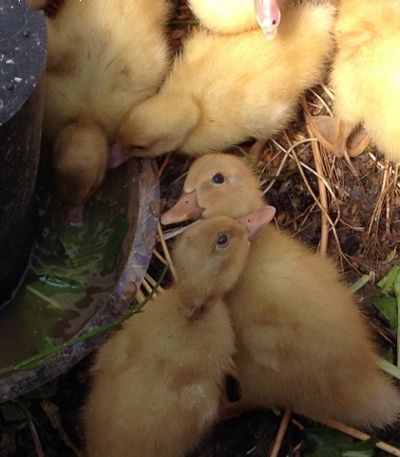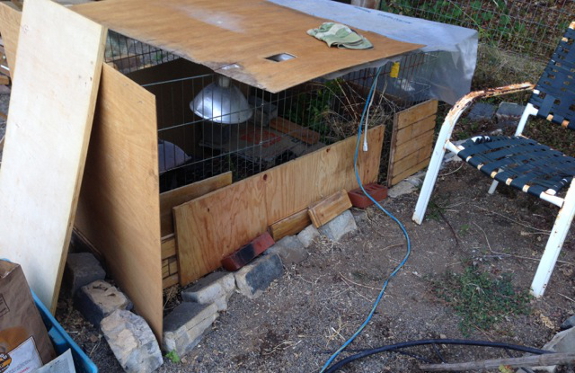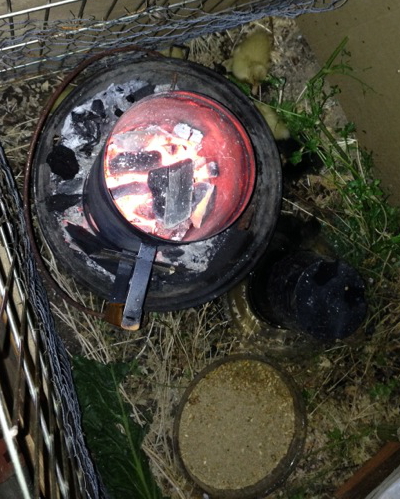
Off-grid ducklings

My two female ducks (no
specific breed, barnyard duck . . . may have some runner) started
setting; the second time this season. This past spring every single egg
they set on was infertile. When they became broody again, I researched
the Muscovy drake/’normal’ duck breed cross a bit more. I learned that
in natural breeding settings, these only have a 20-30% fertility rate.
No wonder the spring eggs were all infertile! I ordered a dozen
ducklings from a hatchery, for delivery the week the broody ducks would
be hatching, if any of their eggs were fertile. I had grand plans of
foster ducklings and happy foster mother ducks.
 The
ducklings hatched August 31st and arrived at the local post office
September 2nd. No foster duck success. What to do with all of this
cuteness? I sort of forgot that I am off-grid!
The
ducklings hatched August 31st and arrived at the local post office
September 2nd. No foster duck success. What to do with all of this
cuteness? I sort of forgot that I am off-grid!
Looking around, I have a
greenhouse (although the sides are rolled up for summer), an old very
small charcoal kettle grill, two bags of lump charcoal (leftover from
making a charcoal walled evaporative coolbox which I use to keep food
cooler on the hottest summer days), and a top of tank propane heater
(normally used in the winter in my covered, but by no means enclosed
propane camp shower.) I have 600Ah of battery capacity and 790W solar. I
use about 60Ah/day for my normal living (~10% of my battery power.) I
have the idea for charcoal heat from travel in Africa, where I’ve seen
small-scale poultry producers use charcoal heaters for brooding. The
ones they use last about 8 hours before needing refilling, per
conversations with the producers.

I set the ducklings up in a
pen directly on a bed in the greenhouse. I placed small bits of plywood
and cardboard all around the pen to limit drafts. Storey’s Guide to Raising Ducks mentions that in mild weather, a low insulated area can be used by the ducklings to keep warm utilizing their own body heat.
I used remnants of 2x4’s for sides, against a cardboard draft guard as
the back, and open on the front. It is only 3 2x4’s high, so about 5
inches high. I cut 4 pieces of cardboard to layer on top, as insulation.
It is dark and I’ve had to herd the ducklings in a few times, so they
can get used to it.  They
actually haven’t really used it at all. That is meant to be a place to
get warm during the day, when the sun goes behind the clouds. They have
enjoyed climbing on top of it though. So far the ducklings haven’t shown
any real signs of being chilly during the main part of the day between
the draft guards and the protection and extra warmth of the greenhouse.
They
actually haven’t really used it at all. That is meant to be a place to
get warm during the day, when the sun goes behind the clouds. They have
enjoyed climbing on top of it though. So far the ducklings haven’t shown
any real signs of being chilly during the main part of the day between
the draft guards and the protection and extra warmth of the greenhouse.
My principal heat has been
the charcoal kettle grill and charcoal starter. I set up four bricks
(flat – 2 bricks high.) They have a brick’s worth of space between the
two stacks. This is the base. I set the small kettle grill on top of
that (my little grill is very old and doesn’t have legs – the grill body
goes directly on the bricks) and then start a full charcoal starter set
inside. When I dumped the lit charcoal into the kettle, as if I were
going to barbeque, it did heat the entire base  well,
but the charcoal also burned out relatively quickly. If I leave the
charcoal in the charcoal starter, and set the lid of the kettle grill
perched on top, it will last ~3 hours and puts out a lot of heat. I
start it about 6pm and then refresh the charcoal at 9pm, 12pm, 3am, and
6am. It takes not quite one 8.8lb bag of charcoal for that period.
well,
but the charcoal also burned out relatively quickly. If I leave the
charcoal in the charcoal starter, and set the lid of the kettle grill
perched on top, it will last ~3 hours and puts out a lot of heat. I
start it about 6pm and then refresh the charcoal at 9pm, 12pm, 3am, and
6am. It takes not quite one 8.8lb bag of charcoal for that period.
I’ve borrowed a standard
heatlamp from my neighbors. I use that for my shoulder periods. It warms
up immediately and I have it hanging ready to plug in. It uses about
30amps/hour, or about 5% of my battery bank/hour. That is A LOT of
power. My solar system can’t handle that all the time, but for a couple
of hours a day it is a good backup – when the charcoal finishes in the
morning, if the sun isn’t fully up, or if the greenhouse gets shaded,
while I’m starting up some charcoal.
I haven’t yet used my top of
tank propane heater (my plan C). I’m mostly concerned about risk of
fire. If I had been planning ahead and ready to brood ducklings (instead
of coming up with solutions on the fly), I would likely want to try a
small propane hog farrower such as Gasolec makes. For now, I’m very
happy with the heat the charcoal is giving, and the fact the ducks
appear to be sufficiently warm during the day without extra heat due to
the greenhouse.

The ducklings go under the
kettle grill and between the bricks when charcoal is burning in the
charcoal starter, set within the grill. It is very easy to light and
heats up fairly quickly. I am sleeping within the greenhouse (the
weather is quite beautiful and I want to be near, in case the ducklings
need me while I’m working out the kinks). I set my alarm for about 3
hours. At times, there are still a few coals, and I only need to add
more charcoal. Often the charcoal is out though. The ducklings are still
doing well though and there is significant heat built up in the bricks
the grill is setting on to tide them over until I get more charcoal
going. I would like to get to up the 8 hours that my off-grid
compatriots in Africa get. I’m going to try to rig a longer charcoal
starter type of tool from 6” stove pipe.
I was worried that the
ducklings might burn themselves on the charcoal kettle grill. They are
walking underneath it and cuddling next to it (but it is just above
them.) They could easily reach it, if they were interested. No one has
singed themselves yet! I will likely need to raise it up another two
bricks, as they grow.
I would love to hear other experiences with off-grid, non-traditional
brooding. I didn’t really plan on brooding these babies, but my master
foster mother plan was a complete fail. Now that I’m figuring it out, I
might do it on purpose with meat birds in the spring. (My ducklings are
Cayuga, the little black ones, and Buff; all from Metzer Hatchery.)
Charity Hanif homesteads in the paradise of the Oregon Coast, between international economic development visits to Africa.
Want more in-depth information? Browse through our books.
Or explore more posts by date or by subject.
About us: Anna Hess and Mark Hamilton spent over a decade living self-sufficiently in the mountains of Virginia before moving north to start over from scratch in the foothills of Ohio. They've experimented with permaculture, no-till gardening, trailersteading, home-based microbusinesses and much more, writing about their adventures in both blogs and books.
Want to be notified when new comments are posted on this page? Click on the RSS button after you add a comment to subscribe to the comment feed, or simply check the box beside "email replies to me" while writing your comment.
- Remove comment
- Remove comment
